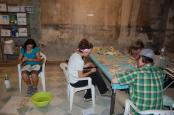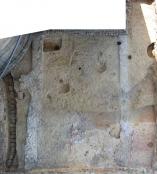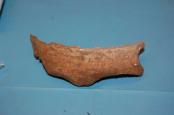CAMPAGNA 2012 |
1° SETTIMANA |
2° SETTIMANA |
3° SETTIMANA |
4° SETTIMANA |
5° SETTIMANA |
6° SETTIMANA |
18 LUGLIO 2012 
Resoconto della giornata di scavo
Area 1000
Abbiamo concluso oggi lo scavo dell’ossario US 1089, messo in luce già nella scorsa campagna di scavo. Nella porzione nord di questo è stato rinvenuto il limite di un altro taglio circolare di cui non si può, per il momento, individuare il completo perimetro. Il nuovo taglio (US -1141) intercetta altre ossa umane e sembra avere un andamento obliquo. Lo scavo dell’area limitrofa a queste evidenze potrà chiarire la sequenza stratigrafica. Continua poi la pulizia e la rimozione degli strati di accumulo di età molto recente nella porzione Nord-Est dell’area di scavo che mettono in luce scassi orizzontali orientati in senso Nord-Sud, forse relativi a fasi agricole contestualizzabili tra il XVII e il XVIII secolo.
Today in area 1000,
excavations continued on the ossuary with the removal of the remaining visible
bones. In the North end of the ossuary a small pit was located containing a
mixture of skeletal remains. In addition, the entire area exposed during last field
season and this year was cleaned extensively and photographed in preparation
for further excavation to older layers.
Area 2000
L’attenzione oggi è stata
totalmente rivolta al Settore A.
All’interno della fossa sepolcrale US -2229 (la più recente delle tre
individuate ieri) inizia a emergere l’individuo in connessione (Us 2234),
di cui sono stati messi in luce il
cranio e, in modo parziale, gli arti superiori flessi sull’addome. Oltre al
ritrovamento di alcuni grani di rosario intrecciati tra le mani, è stata
documentata una riduzione (US 2235) probabilmente relazionata ad un
unico individuo che, al momento della deposizione di Us 2234, è stato
ridotto ed accumulato lungo i lati corti della fossa. Durante la rimozione di
tali ossa è stato osservato un taglio chirurgico praticato sul cranio ridotto
subito al di sopra delle orbite.
Interessante anche il ritrovamento di un ulteriore individuo (Us 2237),
la cui fossa si dispone all’interno della struttura laterizia con orientamento
NE/SW; di questo sono stati messi in luce il cranio, ottimamente preservato, la
scapola e l’omero sinistro ed alcune
coste. Il taglio sepolcrale intercetta parzialmente la vasca nell’angolo Sud
occidentale e ciò permette di identificare il proseguimento del taglio con
quello individuato nelle scorse settimane ad una quota relativamente più bassa.
Rimosso inoltre l’ossario US
2031 nella porzione Nord occidentale dell’area.
The group remained separated into multiple groups with some working in the excavation area and others working in the osteo lab. Walker and Veronica were in the osteo lab again today finishing up the skeleton they had started yesterday. The skeleton was thoroughly cleaned of loose dirt and organized in such a manor they could glue the pieces back together. Before gluing could commence however the pieces had to be labeled according to the site they were discovered in, which was US 3160, labeling down to the smallest of pieces. Once this was complete they could begin piecing the bones back together. Which was difficult as they must have enough points of contact to even begin gluing. After much reconstruction of the skeleton was complete they were able to sex and age the skeleton determining that it was male somewhere around 30-34 years of age. Along with aging, measurements were taken of all complete long bones and the vertebrae that were still whole. Pathologies were also looked for finding some issues with periostitis on the tibia and fibula. As for the others who remained in the excavation area they continued to work on multiple fills containing human remains. Molly and Alexa worked together on fill 2235 which contained a skeletal burial and other burials on top in a complex order of bone fragments yet to be fully explained. With the disconnected bones they also uncovered three skulls, two of them complete and one partial skull. One of the skulls found had appeared to be cut by saw postmortem indicating possible autopsy of the individual before they were buried. Aside from the bones they also uncovered a rosary containing several blue beads. The last two members of the group Adam and Claire worked on fill 2231 which is believed to be an ossuary pit located north and west of the of the brick structure. They worked on recovering two complete skulls one male and one female. There was some disconnected bone fragments around the skulls in the ossuary and they also unearthed some beads within the pit. Although they didn't uncover it themselves east of there pit a fully articulated skeleton was found cut by a disarticulated secondary burial which has yet to be explained.
Area 3000
Nella giornata di oggi, dopo aver fotografato e documentato entrambi i tagli delle fosse sepolcrali ( UUSS – 3175, - 3179) scavati precedentemente, si è proceduto con un’ulteriore indagine del Settore A, che ha permesso l’individuazione di un’altra sepoltura ( US 3084). L’individuo si presenta in pessimo stato di conservazione, tale da poter identificare con difficoltà le ossa presenti, è deposto in decubito dorsale ed è orientato W-E, nella porzione N-W dell’area. Del cranio, mal preservato e schiacciato dall’alto, rimane solo parte della mandibola, con alcuni denti ancora in alveolo, mentre del resto del corpo è possibile osservare solo alcuni frammenti delle diafisi di entrambi gli omeri ed alcune coste dell’emitorace destro. La sepoltura risulta inoltre essere tagliata al livello dell’epifisi distale degli arti superiori ed è assente anche l’intero emitorace sinistro. Prosegue inoltre la messa in luce della riduzione US 3180, nella porzione centro-meridionale dell’area, che probabilmente non ha interessato un unico individuo, ma due, di cui uno di essi infantile, come sembra confermare il rinvenimento di una piccola parte della mandibola con il molare ancora in situ. Vicino al frammento di coxale è stato inoltre evidenziata la presenza di un piede destro, in connessione anatomica, articolato con la tibia ( di cui si conserva solo l’epifisi distale) e la fibula. Si può quindi ipotizzare la presenza di un’ulteriore sepoltura, deposta in decubito dorsale ed orientata N-S, la cui reale presenza deve ancora essere verificata, così come le possibili relazioni fra le due deposizioni.
Today Amanda, Michael
,and Heather worked on removing the skeleton in the south central region of the
site. As the excavation continued, the maxillary was uncovered with the skull
and contained several teeth and an intact palate. Long bones were also removed.
Frank worked to remove the skeletons. The northwest corner of the area. The
individual was vert fragmented and difficult to remove. He and Amanda also
worked to remove a burial a foot south of the other skeleton. They exposed a
left and right humerus as well as the frontal part of the skull. The burial was
cut in half most likely by another burial. Emilia worked doing GIS and Emma
worked in the bone lab.
Area 4000
Nella mattinata entrambi i settori dell’area, l’A (indagato durante la scorsa campagna di scavo) ed il B (il settore risultante dall’allargamento eseguito all’inizio della campagna attuale), sono stati interamente ripuliti per iniziare una contestualizzazione globale dell’intera area. Si è poi proceduto al rilievo, tramite photo markers, di tutti i contesti visibili. Una volta completata l’intera documentazione stratigrafica dell’area è stato possibile iniziare a rimuovere le UUSS relative alle fasi ottocentesche : US 4079, US 4067, US 4080, US 4068 ed US 4081. È iniziata inoltre l’indagine su US 4071, dato che sulla sua porzione orientale sembra essere presente un taglio con rispettivo riempimento. L’ipotesi attuale è che possa essere legato a quella che ormai sembra essere una situazione cantierale presente nella porzione meridionale dell’area (buche per lo spengimento della calce, buche riempite di calce per l’alloggiamento di pali ed il pozzo nell’angolo sud-est).
Today on the 18th of
July 2012 we finished excavating US 4070 and cleaned all of area 4000 including
section A (the older section excavated in the summer of 2011). After placing
photo markers around each respective area, Alessandro and Francesco took a
photo of each area. Upon completing the photos, the GIS people recorded the
elevation and location of each significant point. Afterward we updated our
sketches of each area and then proceeded to remove the mortar and dirt levels of the following areas: 4079, 4067,
4080, 4068, 4081. We are also investigating the cut in 4071 in order to better
understand the context of the area.














